
- •Brief Contents
- •Contents
- •Preface
- •Who Should Use this Book
- •Philosophy
- •A Short Word on Experiments
- •Acknowledgments
- •Rational Choice Theory and Rational Modeling
- •Rationality and Demand Curves
- •Bounded Rationality and Model Types
- •References
- •Rational Choice with Fixed and Marginal Costs
- •Fixed versus Sunk Costs
- •The Sunk Cost Fallacy
- •Theory and Reactions to Sunk Cost
- •History and Notes
- •Rational Explanations for the Sunk Cost Fallacy
- •Transaction Utility and Flat-Rate Bias
- •Procedural Explanations for Flat-Rate Bias
- •Rational Explanations for Flat-Rate Bias
- •History and Notes
- •Theory and Reference-Dependent Preferences
- •Rational Choice with Income from Varying Sources
- •The Theory of Mental Accounting
- •Budgeting and Consumption Bundles
- •Accounts, Integrating, or Segregating
- •Payment Decoupling, Prepurchase, and Credit Card Purchases
- •Investments and Opening and Closing Accounts
- •Reference Points and Indifference Curves
- •Rational Choice, Temptation and Gifts versus Cash
- •Budgets, Accounts, Temptation, and Gifts
- •Rational Choice over Time
- •References
- •Rational Choice and Default Options
- •Rational Explanations of the Status Quo Bias
- •History and Notes
- •Reference Points, Indifference Curves, and the Consumer Problem
- •An Evolutionary Explanation for Loss Aversion
- •Rational Choice and Getting and Giving Up Goods
- •Loss Aversion and the Endowment Effect
- •Rational Explanations for the Endowment Effect
- •History and Notes
- •Thought Questions
- •Rational Bidding in Auctions
- •Procedural Explanations for Overbidding
- •Levels of Rationality
- •Bidding Heuristics and Transparency
- •Rational Bidding under Dutch and First-Price Auctions
- •History and Notes
- •Rational Prices in English, Dutch, and First-Price Auctions
- •Auction with Uncertainty
- •Rational Bidding under Uncertainty
- •History and Notes
- •References
- •Multiple Rational Choice with Certainty and Uncertainty
- •The Portfolio Problem
- •Narrow versus Broad Bracketing
- •Bracketing the Portfolio Problem
- •More than the Sum of Its Parts
- •The Utility Function and Risk Aversion
- •Bracketing and Variety
- •Rational Bracketing for Variety
- •Changing Preferences, Adding Up, and Choice Bracketing
- •Addiction and Melioration
- •Narrow Bracketing and Motivation
- •Behavioral Bracketing
- •History and Notes
- •Rational Explanations for Bracketing Behavior
- •Statistical Inference and Information
- •Calibration Exercises
- •Representativeness
- •Conjunction Bias
- •The Law of Small Numbers
- •Conservatism versus Representativeness
- •Availability Heuristic
- •Bias, Bigotry, and Availability
- •History and Notes
- •References
- •Rational Information Search
- •Risk Aversion and Production
- •Self-Serving Bias
- •Is Bad Information Bad?
- •History and Notes
- •Thought Questions
- •Rational Decision under Risk
- •Independence and Rational Decision under Risk
- •Allowing Violations of Independence
- •The Shape of Indifference Curves
- •Evidence on the Shape of Probability Weights
- •Probability Weights without Preferences for the Inferior
- •History and Notes
- •Thought Questions
- •Risk Aversion, Risk Loving, and Loss Aversion
- •Prospect Theory
- •Prospect Theory and Indifference Curves
- •Does Prospect Theory Solve the Whole Problem?
- •Prospect Theory and Risk Aversion in Small Gambles
- •History and Notes
- •References
- •The Standard Models of Intertemporal Choice
- •Making Decisions for Our Future Self
- •Projection Bias and Addiction
- •The Role of Emotions and Visceral Factors in Choice
- •Modeling the Hot–Cold Empathy Gap
- •Hindsight Bias and the Curse of Knowledge
- •History and Notes
- •Thought Questions
- •The Fully Additive Model
- •Discounting in Continuous Time
- •Why Would Discounting Be Stable?
- •Naïve Hyperbolic Discounting
- •Naïve Quasi-Hyperbolic Discounting
- •The Common Difference Effect
- •The Absolute Magnitude Effect
- •History and Notes
- •References
- •Rationality and the Possibility of Committing
- •Commitment under Time Inconsistency
- •Choosing When to Do It
- •Of Sophisticates and Naïfs
- •Uncommitting
- •History and Notes
- •Thought Questions
- •Rationality and Altruism
- •Public Goods Provision and Altruistic Behavior
- •History and Notes
- •Thought Questions
- •Inequity Aversion
- •Holding Firms Accountable in a Competitive Marketplace
- •Fairness
- •Kindness Functions
- •Psychological Games
- •History and Notes
- •References
- •Of Trust and Trustworthiness
- •Trust in the Marketplace
- •Trust and Distrust
- •Reciprocity
- •History and Notes
- •References
- •Glossary
- •Index
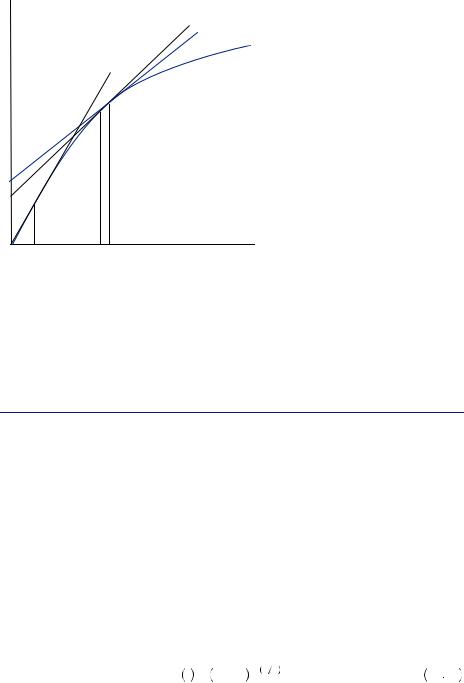
|
|
|
|
|
318 |
|
NAÏVE PROCRASTINATION |
u
slope = δ –j–1 K slope = δ –j K
u(c)
slope = δ –j–n K
FIGURE 12.3 |
|
|
|
Consumption |
cj + n |
cj +1 cj |
c |
Smoothing |
Alternatively, in the SNAP data, we observe a sharp decline in food consumption in the last week. This signals yet again that the behavior is contradicting the standard economic model of choice. The rational model suggests that recipients will have the foresight to conserve their money to consume similar amounts every day rather than consume a lot up front and then run out of food and money in the last week of the month. A time-consistent model of decision making would not predict this behavior, nor can it be reconciled.
Naïve Hyperbolic Discounting
Robert H. Strotz first proposed a model of time-inconsistent preferences due to discounting that varies by the time horizon. Generally, he examined cases in which discount factors in the near term are relatively small, indicating that consumption now is much more valuable than in the near future. However, discount factors in the distant future are much closer to 1. His proposed model was used primarily as a method to explore the potential generalizations of the common exponential discounting model that might permit time-inconsistent preferences. Since his proposal, many have found empirical support for the notion of timeinconsistent preferences; George W. Ainsley proposed a model that, with some later modifications, is commonly called hyperbolic discounting. Hyperbolic discounting replaces the common exponential discount, δt, with the hyperbolic discount factor
h t = 1 + αt − β α , |
12 19 |
where β, α > 0 are parameters and t is the amount of time that will have passed by the instance of consumption. Thus, the consumer maximizes
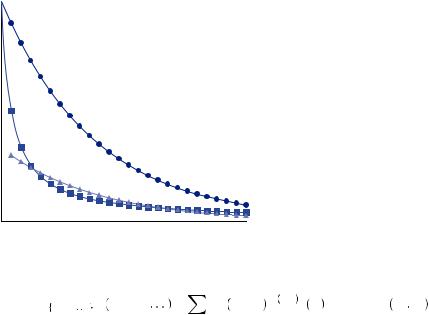
|
|
|
|
Naïve Hyperbolic Discounting |
|
319 |
|
Discount factor
Time discounting
1 
0.9
0.8
0.7
0.6
0.5
0.4
0.3
0.2
0.1
0 0 |
5 |
10 |
15 |
20 |
25 |
|
|
|
Time |
|
|
FIGURE 12.4
Hyperbolic (Squares) and Quasi-Hyperbolic
(Triangles) Time Discounting
max c1, c2, U c1, c2, |
= |
1 + αi − β α |
u ci . |
12 20 |
|
|
T |
|
|
i = 1
Ainsley has found this form to be consistent with the behavior of animals in behavioral experiments introducing intertemporal choice, as well as with human behavior in similar experiments. Figure 12.4 displays the hyperbolic discount factor as well as the exponential discount factor for up to 25 time periods. The squares mark the hyperbolic discount factor and the circles mark the exponential discount factor. The hyperbolic discount factor declines very quickly over the first few time periods compared to the exponential discount function. Thus, a consumer behaving according to hyperbolic discounting will value near-term future consumption much less than someone who discounts according to exponential discounting. Alternatively, the hyperbolic discount function declines very slowly over the latter periods relative to the exponential discount function. Thus, a consumer who displays hyperbolic time discounting is much more willing to delay consumption in the distant future than in the near future. Values of the hyperbolic discount function for various parameter values and selected periods are displayed in Table 12.1. Note that the discount factor is increasing in α and decreasing in β and t.
Consider two questions posed by Richard Thaler. The first question is, “Would you rather have one apple today or two apples tomorrow?” Many people, when posed this question, consider that it is not worth it to wait a whole day just to obtain an additional apple. Thus, they elect to have the apple today. Let u 1
1 be the instantaneous utility obtained from eating one apple, u
be the instantaneous utility obtained from eating one apple, u 2
2 be the instantaneous utility obtained from eating two apples, and δ the daily discount factor applied to decisions for consumption today versus tomorrow. Then choosing the apple today instead of two tomorrow implies u
be the instantaneous utility obtained from eating two apples, and δ the daily discount factor applied to decisions for consumption today versus tomorrow. Then choosing the apple today instead of two tomorrow implies u 1
1 > δu
> δu 2
2 . Now consider the second question: “Would you rather have one apple one year from now, or two apples one year and one day from now?” Many respond to this
. Now consider the second question: “Would you rather have one apple one year from now, or two apples one year and one day from now?” Many respond to this
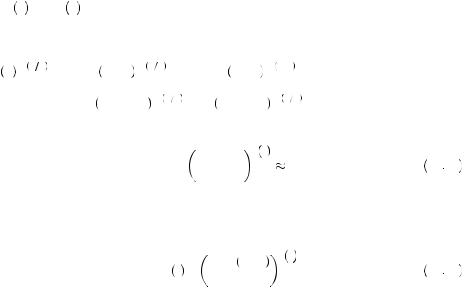
|
|
|
|
|
|
|
|
|
|
|
|
|
|
|
|
320 |
|
NAÏVE PROCRASTINATION |
|
|
|
|
|
|
|
|
|
||
|
|
|
Table 12.1 Values of the Hyperbolic Discount Function |
|
|
|||||||||
|
|
|
for Various Parameters |
|
|
|
|
|
|
|
|
|
||
|
|
|
|
|
|
|
|
|
|
|
||||
|
|
|
α = |
β = |
t =1 |
t = 2 |
t =5 |
t =20 |
t =100 |
t =200 |
||||
|
|
|
|
|
|
|
|
|
|
|
|
|||
|
|
0.10 |
0.10 |
0.91 |
0.83 |
|
0.67 |
0.33 |
0.09 |
0.05 |
||||
|
|
0.20 |
0.10 |
0.91 |
0.85 |
|
0.71 |
0.45 |
0.22 |
0.16 |
||||
|
|
0.50 |
0.10 |
0.92 |
0.87 |
|
0.78 |
0.62 |
0.46 |
0.40 |
||||
|
|
1.00 |
0.10 |
0.93 |
0.90 |
|
0.84 |
0.74 |
0.63 |
0.59 |
||||
|
|
2.00 |
0.10 |
0.95 |
0.92 |
|
0.89 |
0.83 |
0.77 |
0.74 |
||||
|
|
0.10 |
0.20 |
0.83 |
0.69 |
|
0.44 |
0.11 |
0.01 |
0.00 |
||||
|
|
0.20 |
0.20 |
0.83 |
0.71 |
|
0.50 |
0.20 |
0.05 |
0.02 |
||||
|
|
0.50 |
0.20 |
0.85 |
0.76 |
|
0.61 |
0.38 |
0.21 |
0.16 |
||||
|
|
1.00 |
0.20 |
0.87 |
0.80 |
|
0.70 |
0.54 |
0.40 |
0.35 |
||||
|
|
2.00 |
0.20 |
0.90 |
0.85 |
|
0.79 |
0.69 |
0.59 |
0.55 |
||||
|
|
0.10 |
0.50 |
0.62 |
0.40 |
|
0.13 |
0.00 |
0.00 |
0.00 |
||||
|
|
0.20 |
0.50 |
0.63 |
0.43 |
|
0.18 |
0.02 |
0.00 |
0.00 |
||||
|
|
0.50 |
0.50 |
0.67 |
0.50 |
|
0.29 |
0.09 |
0.02 |
0.01 |
||||
|
|
1.00 |
0.50 |
0.71 |
0.58 |
|
0.41 |
0.22 |
0.10 |
0.07 |
||||
|
|
2.00 |
0.50 |
0.76 |
0.67 |
|
0.55 |
0.40 |
0.27 |
0.22 |
||||
|
|
|
|
|||||||||||
|
|
|
question by thinking one year and a day is not much different from waiting one year, and |
|||||||||||
|
|
|
this small wait will result in twice the number of apples. Thus the majority select to wait |
|||||||||||
|
|
|
the extra day. This is a clear violation of the stationarity property described earlier in |
|||||||||||
|
|
|
this chapter. |
|
|
|
|
|
|
|
|
|
|
|
|
|
|
Let ψ be the daily discount factor for decisions regarding consumption one year from |
|||||||||||
|
|
|
now |
and γ the |
discount |
applied for |
waiting |
one year. This |
then |
implies that |
||||
|
|
|
γu 1 |
< γψu 2 . Choosing one apple today and two apples a year and a day from now |
||||||||||
|
|
can only be reconciled if δ < ψ—if the daily percentage discount decreases over time. |
||||||||||||
|
|
The hyperbolic discount rate can accommodate this difference. For example, the |
||||||||||||
|
|
hyperbolic discount rate for period 0 |
(today), |
and period 1(tomorrow) would be |
||||||||||
|
|
|
1 − β α = 1 and |
1 + α − β α . Thus δ = 1 + α − β α < 1. If α is large enough, δ is |
||||||||||
|
|
|
much smaller than 1. Alternatively, the discount applied to one year out and one year |
|||||||||||
|
|
|
and one day are |
1 + α365 |
− β α |
and |
1 + α366 |
− β α , respectively. Thus the daily |
||||||
|
|
|
discount one year out is |
|
|
|
|
|
|
|
|
|
||
|
|
|
|
|
|
ψ = |
1 + |
α366 |
− αβ |
1. |
|
12 21 |
||
|
|
|
|
|
|
|
|
|||||||
|
|
|
|
|
|
|
|
|
|
|
||||
|
|
|
|
|
|
|
1 + α365 |
|
|
|||||
|
|
|
This is a potential solution to the apple conundrum. |
|
|
|||||||||
|
|
|
In general, the discount factor applied from one period to the next has the form |
|||||||||||
|
|
|
|
|
|
ψ t = |
1 + α t + 1 |
− αβ |
|
|
||||
|
|
|
|
|
|
, |
|
12 22 |
||||||
|
|
|
|
|
|
|
|
|||||||
|
|
|
|
|
|
|
|
|
|
1 + αt |
|
|
|
|
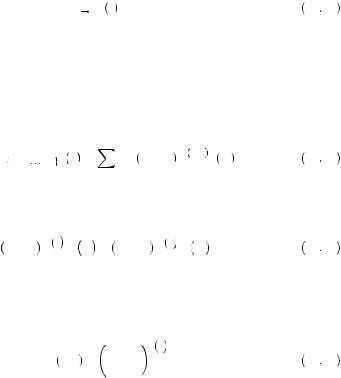
|
|
|
|
Naïve Hyperbolic Discounting |
|
321 |
|
which converges to ψ t
t = 1 as t increases toward infinity. Thus, in the long run the period-by-period discount rate always goes to 1. Alternatively, the rate can be quite small for smaller values of t, particularly if α is large. If instead α is small, elementary calculus tells us that the value of the discount factor converges to
= 1 as t increases toward infinity. Thus, in the long run the period-by-period discount rate always goes to 1. Alternatively, the rate can be quite small for smaller values of t, particularly if α is large. If instead α is small, elementary calculus tells us that the value of the discount factor converges to
limα 0ψ t = e − β, |
12 23 |
which is a constant. Thus, when α is very small, the hyperbolic discount function behaves much like exponential discounting, with δ = e − β.
Let us revisit the behavior observed by food stamp (or SNAP) participants. If they display a sharply higher level of consumption in the first week of the month than in the last, it may be due to hyperbolic time discounting. If a SNAP recipient is a hyperbolic discounter, then on the first day of the month, she will solve
max x, c0, c30 v x + |
30 |
+ αt |
− β α u ct |
|
1 |
12 24 |
|||
|
t = 0 |
|
|
|
subject to the constraints equations 12.16 and 12.17. Now instead of equation 12.18, the consumption for any two periods j and k must conform to
1 + αj − αβ |
u′ cj = 1 + αk − αβ |
u′ ck , |
12 25 |
where, as before, u′ c
c is the marginal instantaneous utility function evaluated at c, and let j < k. Equation 12.25 implies that the discount applied to the utility of consumption between any two periods j and k will be
is the marginal instantaneous utility function evaluated at c, and let j < k. Equation 12.25 implies that the discount applied to the utility of consumption between any two periods j and k will be
ψ j, k = |
1 + αk |
− |
αβ |
|
|
. |
12 26 |
||
1 + αj |
|
|||
|
|
|
|
Consider the case if we hold j constant and adjust k. Because of the hyperbolic shape of the function, in many cases ψ j, k
j, k is substantially lower than one when j and k are relatively close together. Thus, as pictured in Figure 12.5, it may be that planned consumption changes by a relatively large and abrupt amount from one period to the next. In other words, consumption might not be so smooth in the near term. The recipient might convince herself that consumption now is extremely important relative to tomorrow but that it is not nearly so important to consume tomorrow rather than the next day. Thus, because ψ
is substantially lower than one when j and k are relatively close together. Thus, as pictured in Figure 12.5, it may be that planned consumption changes by a relatively large and abrupt amount from one period to the next. In other words, consumption might not be so smooth in the near term. The recipient might convince herself that consumption now is extremely important relative to tomorrow but that it is not nearly so important to consume tomorrow rather than the next day. Thus, because ψ j, j + 1
j, j + 1 converges to 1 as j gets large, planned consumption in the distant future will be smooth, though planned consumption in the near term is not. Thus a SNAP recipient who behaves according to hyperbolic discounting when receiving her benefits will plan to consume a lot today (or maybe in the first week) but then hope to smooth out her consumption over the rest of the month. Figure 12.6 offers another view of this behavior, where discounting between periods 1 and 2 is relatively steep, resulting in very different discounted marginal utility curves. Alternatively, discounting between periods 2 and 3 is very mild, resulting in nearly identical discounted marginal utility curves between periods 2 and 3 when planning from the point of view of period 1.
converges to 1 as j gets large, planned consumption in the distant future will be smooth, though planned consumption in the near term is not. Thus a SNAP recipient who behaves according to hyperbolic discounting when receiving her benefits will plan to consume a lot today (or maybe in the first week) but then hope to smooth out her consumption over the rest of the month. Figure 12.6 offers another view of this behavior, where discounting between periods 1 and 2 is relatively steep, resulting in very different discounted marginal utility curves. Alternatively, discounting between periods 2 and 3 is very mild, resulting in nearly identical discounted marginal utility curves between periods 2 and 3 when planning from the point of view of period 1.
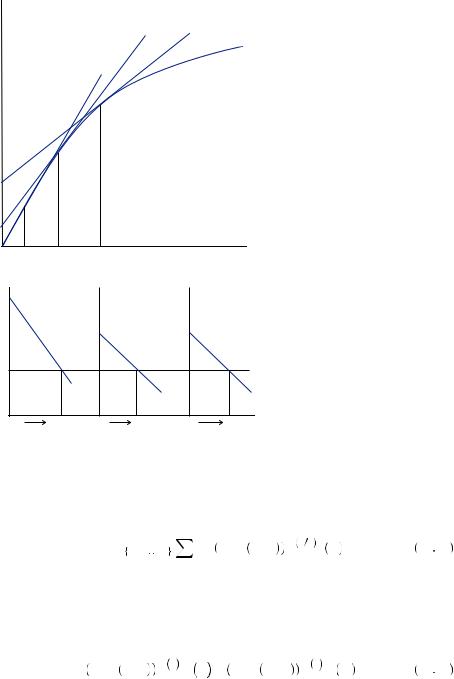
|
|
|
|
|
322 |
|
NAÏVE PROCRASTINATION |
FIGURE 12.5
Hyperbolic Discounting Increases Current Relative to Future Consumption
FIGURE 12.6
Consumption Nonsmoothing under Hyperbolic Discounting
u
slope = h( j+1)–1 K slope = h( j)–1 K
u(c)
slope = h( j+n)–1 K
cj + n |
cj +1 |
cj |
|
|
c |
utility |
u'(c1) |
|
ψ (1,2)u'(c2) |
|
ψ (1,3)u'(c3) |
Discounted marginal |
|
|
|||
|
|
|
|
|
|
c1 |
c1 |
c2 |
c2 |
c3 |
c3 |
But then the rest of the month happens. Unfortunately with time-inconsistent preferences, the recipient does not live by her plan. Instead, when she arrives in the second period, she solves
max c1, c30 |
30 |
+ α t − 1 |
− β α u ct |
|
1 |
12 27 |
|||
|
t = 1 |
|
|
|
subject to new constraints that reflect the consumption of the first day. The new time index in the discount factor reflects that now the recipient is making her plans in period 1 rather than period 0. Thus, now consumption in period 1 enjoys a favored status relative to period 2 and all future periods. The new solution must satisfy
1 + α j − 1 − αβ |
u′ cj = 1 + α k − 1 − αβ |
u′ ck . |
12 28 |
So, where before the difference in the slope of the utility function for consumption in periods j and k could be represented by equation 12.26, now it is represented by
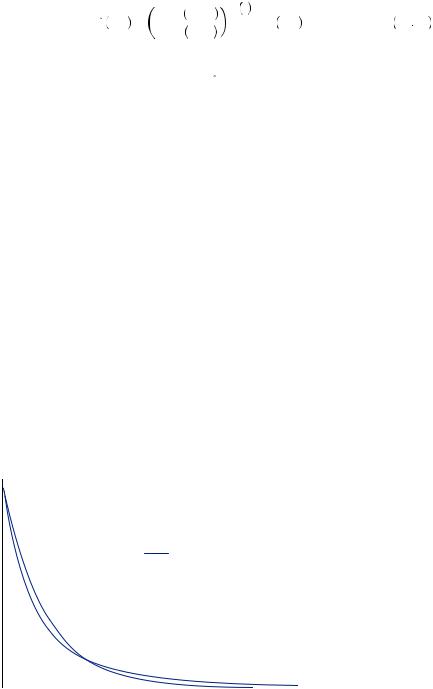
|
|
|
|
|
|
|
|
|
|
|
Naïve Hyperbolic Discounting |
|
323 |
|
|
ψ j, k = |
1 + α k − 1 |
− αβ |
< ψ j, k . |
12 29 |
|
|
|
|
|
|
|||||
|
1 + α j − 1 |
|
|
|
|
|
|
Previously, recipients had anticipated applying a discount of ψ 1, 2
1, 2 between the first and second periods. Now instead, they apply ψ
between the first and second periods. Now instead, they apply ψ 1, 2
1, 2 = ψ
= ψ 0, 1
0, 1 . Thus, despite the plans made previously, recipients now feel that they need to consume more now relative to the future. They thus consume more in period 1 than they had planned, leaving less for the future when they anticipated smoothing their consumption. In the following period, they again decide to consume more than they had planned to in either of the previous periods, again putting off consumption smoothing until a later date. Recipients continue to put off smoothing until they reach a point where they no longer have enough food to last the rest of the month, and their consumption is forced to drop off significantly.
. Thus, despite the plans made previously, recipients now feel that they need to consume more now relative to the future. They thus consume more in period 1 than they had planned, leaving less for the future when they anticipated smoothing their consumption. In the following period, they again decide to consume more than they had planned to in either of the previous periods, again putting off consumption smoothing until a later date. Recipients continue to put off smoothing until they reach a point where they no longer have enough food to last the rest of the month, and their consumption is forced to drop off significantly.
Figure 12.7 displays the planned consumption on the first day of the month for the SNAP problem given a utility of food consumption function, u c
c = c0.7 and a hyperbolic discounting function with α = 0.1, β = 1. The planned consumption is much higher at the beginning of the month than at the end, but it allows some steady but low level of consumption from about day 20 of the monthly cycle onward. Alternatively, the actual level of consumption is obtained by solving the optimization again each period with a new discount function as given in equation 12.28. In this case, recipients decide once they are in the second period that they should consume more than they had planned. They continue to revise their consumption upward until the ninth period. After that, their budget does not allow them to continue to consume more than they had planned. Feast then turns to famine. At that point, they must begin consuming less and less. Consumption in the last 10 days is less than 1/10 of planned consumption and is nearly zero.
= c0.7 and a hyperbolic discounting function with α = 0.1, β = 1. The planned consumption is much higher at the beginning of the month than at the end, but it allows some steady but low level of consumption from about day 20 of the monthly cycle onward. Alternatively, the actual level of consumption is obtained by solving the optimization again each period with a new discount function as given in equation 12.28. In this case, recipients decide once they are in the second period that they should consume more than they had planned. They continue to revise their consumption upward until the ninth period. After that, their budget does not allow them to continue to consume more than they had planned. Feast then turns to famine. At that point, they must begin consuming less and less. Consumption in the last 10 days is less than 1/10 of planned consumption and is nearly zero.
Hyperbolic discounting is a relatively simple way to represent the type of presentbiased preferences, or an extreme discounting of the future, that seems the only explanation for such procrastination behavior. The model suggests that people plan to
Consumption
Planned versus actual consumption
20
15 |
|
|
|
|
|
|
Planned consumption |
|
|
|
|
|
|
|
|
|
|
|
|
||
10 |
|
|
|
|
|
|
Actual consumption |
|
|
|
|
|
|
|
|
|
|
|
|||
|
|
|
|
|
|
|
|
|
|
|
|
|
|
|
|
|
|
|
|
|
|
5 |
|
|
|
|
|
|
|
|
|
|
0 |
|
|
|
|
|
|
|
|
|
FIGURE 12.7 |
|
|
|
|
|
|
|
|
|
|
|
0 |
5 |
10 |
15 |
20 |
25 |
30 The SNAP Problem with Hyperbolic Dis- |
||||
|
|
|
|
|
Time |
|
|
|
counting |
|
